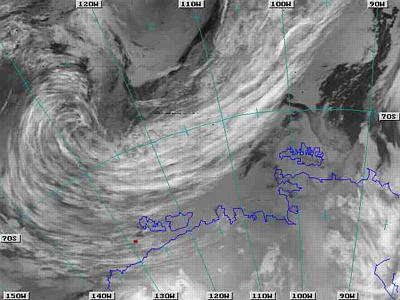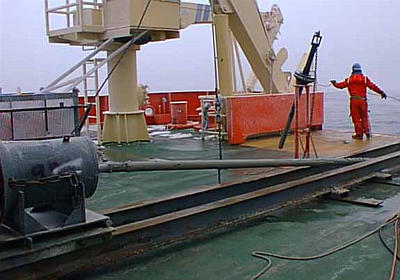2 March, 1999
March 2, 1999
Hello from Antarctica. Today was sure a better day than yesterday! The
winds have died down to about 20 knots. As a result, the seas are much
calmer, and our scientific data looks much better. During my shift, we
took three piston/trigger cores. In addition, we did a nice multibeam
survery, and we ran several hours of seismic. It was great! Tonight, the
night shift will be finishing the seismic work in this area, which is known
as Wrigley Gulf. This parcticular area of water along the Getz Ice Shelf
was named after a Chicago manufacturer who helped finance the USAS (United
States Antarctic Service) expedition of 1940. Next, we will be moving
further east towards Pine Island Bay.
Our questions for today were, "How do you suppose that storms in Antarctica
are different from those in the United States? How are they similar?"
Well, they are the same in that storms are low pressure areas that are
spinning. One of the statistics that I list at the bottom of each journal
is the barometric pressure in millibars. The lower the barometric
pressure, the closer (and the stronger) the storm system.
One difference between storms in the Northern and Southern hemispheres is
the direction in which they spin. In the Northern Hemisphere, low pressure
systems (often referred to as cyclones) spin in a counter-clockwise
direction. Thunderstorms, hurricanes, and tornadoes all follow this
pattern. In the Southern Hemisphere, low pressure systems spin in the
opposite direction -- clockwise! Thunderstorms, hurricanes, and tornadoes
in the Southern Hemisphere may look and feel the same to a casual observer,
but to someone who looks at those storms from a satellite photo, they can
easily see the difference.
Another difference between weather in the United States and weather here
aboard the Nathaniel B. Palmer is the direction from which it comes. In
the United States, most weather patterns are blown across the country from
the west towards the east. That's one of the things that meteorologists
use to help predict the weather for a certain location. The United States
is primarily in an area where the predominant winds come from the west.
The continental U.S. is in a wind belt that is called the "Westerlies,"
which can be found between about 30 and 60 degrees North latitude. There
is also a Westerlies wind belt that exists between 30 and 60 degrees South
latitude.
But I am located at about 74 degrees South latitude. There is a narrow
wind belt that exists between the Westerlies and the continent of
Antarctica that are known as the Coastal Easterlies. In this area, the
predominant wind pattern comes from the east. A similar situation is true
in the Northern Hemisphere, where Polar Easterlies can be found between
about 60 degrees North latitude and the pole. The land mass of Antarctica,
however, keeps the Easterlies in this area much narrower than those in the
Northern Hemisphere. The cold, dense air from the ice-covered continent
flows down from the middle of the land (which is highest in elevation)
towards the coast (which is lower). This is called an inversion wind, and
it is driven by gravity. The spinning of the Earth causes these winds to
turn slightly towards the west, which helps the Coastal Easterlies to
develop (remember, Easterlies come from the east and move towards the
west).
For the last few days, we have been on the edge of a large low-pressure
storm system. As a result, our winds have been fairly high. One way to
measure the force of the wind is to use the Beaufort Wind Scale. This
scale rates the winds from 0 to 12 -- with 0 being very calm and 12 being
exceptionally strong. Here is the Beaufort Wind Scale:
0 Calm <1 miles per hour
1 Light Air 1-3 mph
2 Light Breeze 4-7 mph
3 Gentle Breeze 4-7 mph
4 Moderate Breeze 13-18 mph
5 Fresh Breeze 19-24 mph
6 Strong Breeze 25-31 mph
7 Near Gale 32-38 mph
8 Gale 39-46 mph
9 Strong Gale 47-54 mph
10 Storm 55-63 mph
11 Violent Storm 64-72 mph
12 Hurricane Force 73+ mph
So, for the last few days, we've had "strong gale" force winds. How do
these winds affect the height of the waves? We'll look at that scale in
tomorrow's journal! I hope you're having as great a week as I am! I'm
looking forward to hearing questions from you.
Kim Giesting
Latitude: 74 degrees 03 minutes South
Longitude: 129 degrees 28 minutes West
Temperature: -4.1 degrees C
Barometer: 990.5 mb
Wind Speed: 18.6 knots
Wind Direction: 72 degrees (from the Northeast)
Sunrise: 03:46
Sunset: 19:39

This is a weather satellite image for our region about two days ago. Notice that the storm spins in a clockwise direction. The ship is marked by a red dot. The islands immediately to our east are named Siple Island and Carney Island.

This is a picture that includes both the piston core and and trigger core. The trigger core is in the vertical stand, while the piston core is in a horizontal position.

Ashley and Broxton are recutting the end of the piston core. Sometimes the sediments settle in the core, and the end must be recut to the edge of the sediments.
Contact the TEA in the field at
.
If you cannot connect through your browser, copy the
TEA's e-mail address in the "To:" line of
your favorite e-mail package.
|
